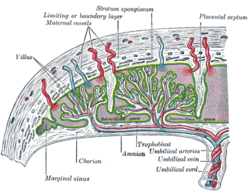Placental microbiome

The placental microbiome is the nonpathogenic, commensal bacteria present in a healthy human placenta and is distinct from bacteria that cause infection and preterm birth in chorioamnionitis.[1] Until recently, the healthy placenta was considered to be a sterile organ but now genera and species have been identified that reside in the basal layer.[1][2][3][4][5]
The placental microbiome more closely resembles that of the oral microbiome than either the vaginal or rectal microbiome.[1]
Bacterial species and genera
Culturable and non-culturable bacterial species in the placenta obtained following normal term pregnancy have been identified.
| Binomial name | Commensal | Transient | Potential pathogen | References |
|---|---|---|---|---|
| Prevotella tannerae | x | x | [3][6][7] | |
| Firmicutes spp | x | x | [2][8] | |
| Tenericutes ssp | x | x | [2] | |
| Fusobacterium nucleatum | x | [9] | ||
| Prevotella tanerae | x | |||
| Bacteroides spp | x | [8] | ||
| Fusobacterium spp | x | |||
| Streptomyces avermitilis | x | [8] | ||
| Neisseria polysaccharea | x | |||
| Neisseria lactamica | x | |||
| Proteobacteria ssp | x | [2][8] | ||
| Bacteroidetes ssp | x | [2] | ||
| Escherichia coli | x | x | [4][7] | |
| Escherichia ssp | x | x | [7] | |
| Actinobacteria ssp | x | [8] | ||
| Cyanobacteria ssp | x | [8] | ||
| Chloroflexi ssp | x | [8] | ||
| Aquificae ssp | x | [8] | ||
| Verrucomicrobia ssp | x | [8] | ||
| Vibrio ssp | x | [8] | ||
| Burkholderia ssp | x | [8] | ||
| Beijerinckia ssp | x | [8] |
A change in the composition of the microbiota in the placenta is associated with excess gestational weight gain, pre-term birth, and decreased overall species richness and variant abundance.[8] The placental microbiota varies between low birth weights and normal birth weights.[10] While bacteria are often found in the amniotic fluid of failed pregnancies, they are also found in particulate matter that is found in about 1% of health pregnancies.[2]
In non-human animals, part of the microbiome is passed onto offspring even before the offspring are born. Bacteriologists assume that the same probably holds true for humans.[2]
References
- 1 2 3 Fox, Chelsea; Eichelberger, Kacey (2015). "Maternal microbiome and pregnancy outcomes". Fertility and Sterility. 104 (6): 1358–1363. doi:10.1016/j.fertnstert.2015.09.037. ISSN 0015-0282. PMID 26493119.
- 1 2 3 4 5 6 7 Wassenaar, T.M.; Panigrahi, P. (2014). "Is a foetus developing in a sterile environment?". Letters in Applied Microbiology. 59 (6): 572–579. doi:10.1111/lam.12334. ISSN 0266-8254. PMID 25273890.
- 1 2 Yarbrough, V. L.; Winkle, S.; Herbst-Kralovetz, M. M. (2014). "Antimicrobial peptides in the female reproductive tract: a critical component of the mucosal immune barrier with physiological and clinical implications". Human Reproduction Update. 21 (3): 353–377. doi:10.1093/humupd/dmu065. ISSN 1355-4786.
- 1 2 Stout, Molly J.; Conlon, Bridget; Landeau, Michele; Lee, Iris; Bower, Carolyn; Zhao, Qiuhong; Roehl, Kimberly A.; Nelson, D. Michael; Macones, George A.; Mysorekar, Indira U. (2013). "Identification of intracellular bacteria in the basal plate of the human placenta in term and preterm gestations". American Journal of Obstetrics and Gynecology. 208 (3): 226.e1–226.e7. doi:10.1016/j.ajog.2013.01.018. ISSN 0002-9378.
- ↑ Schwiertz, Andreas (2016). Microbiota of the human body : implications in health and disease. Switzerland: Springer. p. 1. ISBN 978-3-319-31248-4.
- ↑ Mor, Gil; Kwon, Ja-Young (2015). "Trophoblast-microbiome interaction: a new paradigm on immune regulation". American Journal of Obstetrics and Gynecology. 213 (4): S131–S137. doi:10.1016/j.ajog.2015.06.039. ISSN 0002-9378. PMID 26428492.
- 1 2 3 Todar, K. "Pathogenic E. coli". Online Textbook of Bacteriology. University of Wisconsin–Madison Department of Bacteriology. Retrieved 2007-11-30.
- 1 2 3 4 5 6 7 8 9 10 11 12 13 Antony, Kathleen M.; Ma, Jun; Mitchell, Kristen B.; Racusin, Diana A.; Versalovic, James; Aagaard, Kjersti (2015). "The preterm placental microbiome varies in association with excess maternal gestational weight gain". American Journal of Obstetrics and Gynecology. 212 (5): 653.e1–653.e16. doi:10.1016/j.ajog.2014.12.041. ISSN 0002-9378.
- ↑ Prince, Amanda L.; Antony, Kathleen M.; Chu, Derrick M.; Aagaard, Kjersti M. (2014). "The microbiome, parturition, and timing of birth: more questions than answers". Journal of ReproductiveImmunology. 104-105: 12–19. doi:10.1016/j.jri.2014.03.006. ISSN 0165-0378.
- ↑ Zheng, Jia; Xiao, Xinhua; Zhang, Qian; Mao, Lili; Yu, Miao; Xu, Jianping (2015). "The Placental Microbiome Varies in Association with Low Birth Weight in Full-Term Neonates". Nutrients. 7 (8): 6924–6937. doi:10.3390/nu7085315. ISSN 2072-6643.
See also
- Human microbiome
- Human microbiome project
- Human virome
- List of bacterial vaginosis microbiota
- Microbiota of the lower reproductive tract of women
- Vaginal microbiota in pregnancy